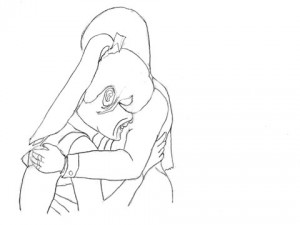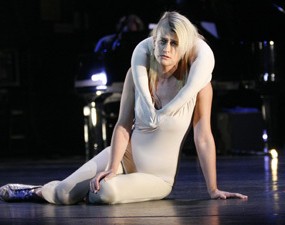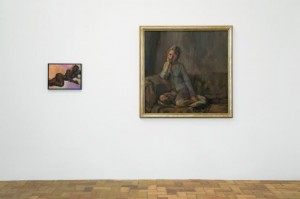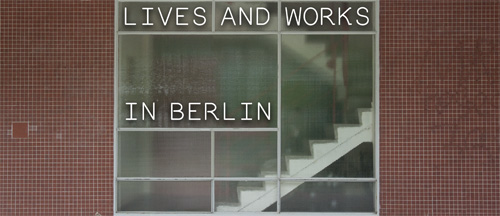
Kara Hearn, "Clear Eyes, Full Hearts," ongoing series. Courtesy of the artist.
Judith Butler, that radical Valkyrie of all things identity politics, caused quite a stir in Berlin recently. On June 19th, she declined the “Civil Courage Prize” awarded by the organizers of Berlin’s Christopher Street Day, accusing them of complicity with the forces of “anti-semitism,” “anti-muslim racism,” and “transphobia.” The whole scene was a bizarre Lynchian dreamscape: Judith Butler speaking perfect yet cryptic German, the shocked emcees sporting angel wings, and the crowd discharging a fratty energy uncommon amongst Judy fans. After her speech, one of the presenters laughed meekly and said, “it wouldn’t be Judith Butler if she would take a prize without any critical remarks.”
The other emcee, noticeably angry, addressed the members of the more “courageous” organizations mentioned in Judy’s speech (GLADT, SUSPECT, LesMigraS, ReachOut ) and said: “To be honest, you’re not the majority here. You’re. Not. The. Majority.”
Whoa. Needless to say, his response was abhorrent, and it certainly doesn’t help to dispel the tired image of Germany as a hulking and largely homogenous nation, which, while progressive in some ways, remains mired in assimilation problems.
The drama hovered over the Transgenialer CSD, an alternative, anti-capitalist, anti-nationalist (no flags allowed even though it was the World Cup) celebration. On a day normally marked by weak mojitos and slurred Nina Hagen covers, it was pretty astonishing that the hottest topic was a philosopher theorist and the concerns of oft-overlooked queer groups.
A few revelers cried hypocrisy at Judy’s supposed first-class flight and paid stay at the Hotel Adlon, the swanky stopover of diplomats and the site where Michael Jackson hung his newborn over a balcony in some psychotic Disney ritual…or in an attempt at an upside down German hello…or something.
Some flatly denied any wrongdoing on the part of the CSD officials, chafing at the idea that an academic unfamiliar with Berlin’s queer community could come in and diagnose all its shortcomings. Why doesn’t she give the money back to the CSD? Why not just accept the award and then transfer it to the groups she cited as more deserving?
Others were giddy about her decline of the prize, arguing that Judy, on her winged steed of righteousness had finally exposed the virulent forces of Islamophobia circulating freely within the LGBTQ community.
I would guess that most people involved with the larger CSD, like one Green Party official I spoke to, were disheartened by Judy’s decline of the award, but happy nonetheless that the subversive act was generating dialogue within a community that desperately needs to address the changing demands of a growing sector.
This Judy drama prompted me to ask myself, how often do I have an artistic experience that engages with ideas of queerness and challenges cultural constructions in a meaningful way? At times Berlin seems like the queerest place on earth, especially with some of its physical locations literally eluding categorization (is it an abandoned high-rise, studio complex, or cruising spot? All three!). At other times, it feels as though there is an endless deluge of man-boy-art-brut painting and a hegemonic masculine inheritance from Herrs Baselitz, Richter, and Rauch.
Donning my queer theory trousers which, admittedly, were better suited to the mentally lithe 23 year-old me, I couldn’t help but ponder a friend’s recent query, “what kind of art would Judy want in her house?”

Peaches Christ Superstar at the Hebbel am Ufer theater in Berlin, March 24, 2010. Image courtesy of Artforum Diary.
She might want a copy of Peaches Christ Superstar, a much-hyped, VERY queer, but surprisingly demure take on Andrew Lloyd Webber’s 1971 musical. The performance, which, according to Peaches’s blog was “resurrected” after a rights dispute between Webber’s people and the ever-controversial performer, was a one-woman restaging of the biblical rock opera at Haueins in Kreuzberg in late March and again in late May (and it might be traveling to a city near you!).
While lyrically faithful to the original, the whole thing seemed futuristic and trippy, with Peaches accompanied only by pianist Chilly Gonzales, a Bladerunneresque leotard and a jerky set of stage lights. During the performance, she voiced every character from Judas to Herod to Mary Magdalene, raising or lowering her register comically to denote a theatrical sex change. Her squirmy self-conscious gestures and overly furrowed brows became beautiful reflections on the malleability of identity, and I couldn’t help but think of Kalup Linzy and his personal brand of gendered melodrama. A growing number of young performance artists are also investigating Butlerian issues of gendered identity through mimicry, exaggeration, and drag: Jill Pangallo, Anthony Romero, and Kara Hearn to name a few.
Earlier this week, Dr. Angela Davis defended Butler’s decline of the prize in language that was both lucid and accessible (and totally Angela Davis-style awesome), encouraging us to question racist or sexist assumptions even within our more “progressive” communities. Over the last few decades thanks to Judy, among others, it’s become more and more accepted that race, sex, and class are like inseparable 13 year-old girls, whose cliquish rebuffs can never quite be attributed to just one culprit. Rather, they are a co-dependent system that functions best when coordinating silly bands under a table, or Facebook water-boarding each other, or whatever it is that 13 year-old girls do these days.

Installation View of "Self Consciousness": from left, Boscoe Holder, “Untitled,” 1988; Celia Paul, “Gillian Sitting,” 1994. Courtesy Veneklasen Werner.
With its astute look at the intersection of race, sex, class and epoch, Self-Consciousness, a Peter Doig and Hilton Als joint curatorial effort at Veneklasen Werner was one of the most sastifying gallery experiences I’ve had in a while. The exhibition (which closed last weekend) was strange, anachronistic, fetishistic, and incredibly disruptive in terms of routine gender presentation. Seemingly about portraiture, it was, I would posit, largely a show about reflections and variants of male sexuality in men of color. This is thanks, in part, to a wealth of paintings depicting the black male nude by the late Boscoe Holder. Holder, an artist/choreographer/designer from Trinidad and Tobago who passed away in 2007, depicts reclining men in a vulnerable way that belies both a subtly assured sensuality and our assumption of what constitutes the “male gaze.”
The curatorial decision to mix “outsider” artists like Holder in with the likes of portrait giant Alice Neel and artstar Chris Ofili could have been disastrous, but instead the show develops its own non-hierarchy, one in which Shirley Clarke’s video of a coquettish gay African-American man smoking can share the same mental space as a DeChirico.
You know, basically the sort of thing Judith Butler would hang in her living room.





Pingback: Sexy, Depressed Berlin
Pingback: I am flattered… | Jill Pangallo
Pingback: Ali Fitzgerald’s Top 9 European Gender-Journeys of 2010 | Art21 Blog